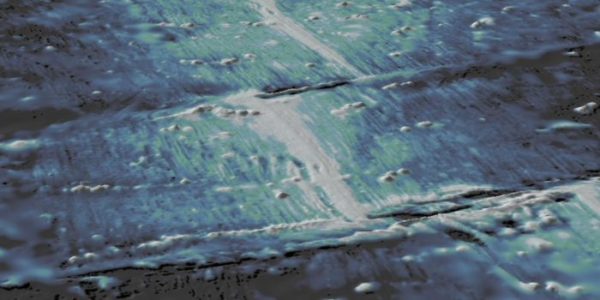Featured image: A perspective view of the seafloor at the East Pacific Rise, 9N. Made with GeoMapApp (www.geomapapp.org, CC-BY), and GMRT topography data (Ryan et al. 2009, CC-BY).
Paper: Do sea level variations influence mid-ocean ridge magma supply? A test using crustal thickness and bathymetry data from the East Pacific Rise
Authors: B. Boulahanis, S. M. Carbotte, P. J. Huybers, M. R. Nedimovic, O. Aghaei, J. P. Canales, and C. H. Langmuir
Many of our records of past sea level come from local measurements from coastal towns logged over decades or centuries, or are estimated from ice or sediment cores spanning the last few thousand years, but new research suggests that much longer records can be found in an unlikely place: imprinted deep underground in the oceanic crust.
Oceanic crust is formed at mid-ocean ridges, which are spreading centers in the oceans where two tectonic plates are separating and the Earth’s mantle wells up to fill the gap. The melting point of any material depends on pressure as well as temperature, so as the mantle rocks rise and the pressure on them decreases, they partially melt, generating the magma that cools and solidifies to form new crust. Oceanic crust is typically about 7 km (4.3 miles) thick. The youngest part of the seafloor is always right at a mid-ocean ridge, and the crust gets progressively older as you move out on either side.
But what does this have to do with sea level? As sea level rises and falls over geologic time, the pressure on the seafloor varies, and that could affect just how much the mantle melts beneath mid-ocean ridges. When sea level is high, pressure is high, the mantle melts slightly less, and the new oceanic crust forming at the ridge will be a little thinner – maybe by 200 m (650 ft) – compared to crust formed during times of lower sea level and pressure.
While this idea sounds simple, it’s actually fairly controversial among geophysicists. A few recent studies have tried to test whether oceanic crustal thickness varies in sync with past changes in sea level associated with Earth’s orbital dynamics, but these studies relied on indirect measurements of crustal thickness and reached conflicting conclusions.
A new study in the Pacific Ocean using more direct measurements of oceanic crustal thickness found bands of alternating thick and thin crust that appear to reflect sea level changes. Bridgit Boulahanis and co-authors measured crustal thickness for a chunk of the seafloor using seismic reflection, a technique where sound waves are sent down into the Earth, and energy that’s reflected off of layers (like the bottom of the oceanic crust) gets recorded back at the surface. By estimating the age of the crust, the authors showed that the thick and thin bands they observe are spaced at intervals that match some of Earth’s major orbital periods, when large-scale changes in glaciation and sea level are expected to occur as the planet periodically moves closer to or farther from the Sun.
Sea level isn’t the only thing that affects the amount of magma produced at mid-ocean ridges, and magma production isn’t even the only thing that changes crustal thickness: blobs of mantle material with slightly different chemistry could yield different amounts of melt, and faults could thin the crust independent of magma. All of these factors probably contribute to variations in the thickness of oceanic crust along with sea level change, but the results of Boulahanis and co-authors provide convincing evidence that millions of years of large-scale sea level history are recorded deep beneath the sea itself.

Climate records written on the seafloor by Hannah Mark is licensed under a Creative Commons Attribution-ShareAlike 4.0 International License.

